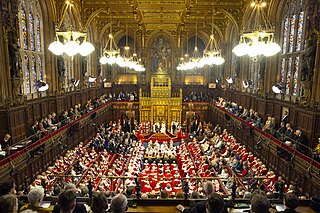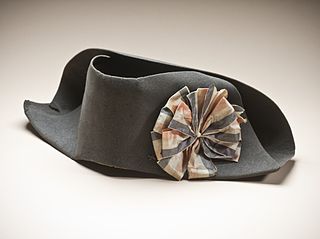
Earl Marshal is a hereditary royal officeholder and chivalric title under the sovereign of the United Kingdom used in England. He is the eighth of the great officers of State in the United Kingdom, ranking beneath the Lord High Constable of England and above the Lord High Admiral. The dukes of Norfolk have held the office since 1672.

The Lord Steward or Lord Steward of the Household is an official of the Royal Household in England. Holders of the office are always peers, until 1924, were always members of the Government, and until 1782, the office was one of considerable political importance and carried Cabinet rank.

The Lord Chamberlain of the Household is the most senior officer of the Royal Household of the United Kingdom, supervising the departments which support and provide advice to the Sovereign of the United Kingdom while also acting as the main channel of communication between the Sovereign and the House of Lords. The office organises all ceremonial activity such as garden parties, state visits, royal weddings, and the State Opening of Parliament. They also oversee the Royal Mews and Royal Travel, as well as the ceremony around the awarding of honours.

The State Opening of Parliament is a ceremonial event which formally marks the beginning of each session of the Parliament of the United Kingdom. At its core is His Majesty's "gracious speech from the throne", which is read by the monarch but written by HM Government. In the speech the monarch gives notice of forthcoming state visits, before setting out the government's legislative programme for the new parliamentary session. No business of either House of Parliament can proceed until the Sovereign’s speech has been delivered.
Government in medieval monarchies generally comprised the king's companions, later becoming the royal household, from which the officers of state arose, initially having household and government duties. Later some of these officers became two: one serving state and one serving household. They were superseded by new officers, or were absorbed by existing officers. Many of the officers became hereditary and thus removed from practical operation of either the state or the household.

A tipstaff is an officer of a court or, in some countries, a law clerk to a judge. The duties of the position vary from country to country. It is also the name of a symbolic rod, which represents the authority of the tipstaff or other officials such as senior police officers.

The bicorne or bicorn (two-cornered) is a historical form of hat widely adopted in the 1790s as an item of uniform by European and American army and naval officers. Most generals and staff officers of the Napoleonic period wore bicornes, which survived as widely-worn full-dress headdress until the 20th century.
An equerry is an officer of honour. Historically, it was a senior attendant with responsibilities for the horses of a person of rank. In contemporary use, it is a personal attendant, usually upon a sovereign, a member of a royal family, or a national representative. The role is equivalent to an aide-de-camp, but the term is now prevalent only among some members of the Commonwealth of Nations.

The Gold Stick and the Silver Stick are formal bodyguard positions in the British Royal Household, serving as personal attendants to the Sovereign on ceremonial occasions.

The Field Officer in Brigade Waiting holds an appointment in the Royal Household. He performs his duties at State Ceremonies under the authority of the Lord Great Chamberlain, the Lord Chamberlain and the Earl Marshal. When dismounted he carries a distinctive baton as his insignia of office.

The ceremonial baton is a short, thick stick-like object, typically in wood or metal, that is traditionally the sign of a field marshal or a similar high-ranking military officer, and carried as a piece of their uniform. The baton is distinguished from the swagger stick in being thicker and effectively without any practical function. A staff of office is rested on the ground; a baton is not. Unlike a royal sceptre that is crowned on one end with an eagle or globe, a baton is typically flat-ended.
The Lord High Steward of Ireland is a hereditary Great Officer of State in the United Kingdom, sometimes known as the Hereditary Great Seneschal. The Earls of Shrewsbury have held the office since the 15th century. Although the Irish Free State, later the Republic of Ireland, became independent in 1922, the title remained the same, rather than reflecting the region of Northern Ireland, which remains within the United Kingdom.
Gentleman Usher and Lady Usher are titles for some officers of the Royal Household of the United Kingdom. For a list of office-holders from the Restoration of the monarchy in 1660 up to the present day see List of Lady and Gentleman Ushers.

The Royal Households of the United Kingdom are the collective departments that support members of the British royal family. Many members of the royal family who undertake public duties have separate households. They vary considerably in size, from the large household that supports the sovereign to the household of the Prince and Princess of Wales, with fewer members.
The Hofmarschall was the administrative official in charge of a princely German court, supervising all its economic affairs.

In the United Kingdom, state funerals are usually reserved for monarchs. The most recent was the state funeral of Queen Elizabeth II on 19 September 2022.
The State Opening of Parliament includes a State Procession, a formal display of the Sovereign, dignified by a sizeable entourage made up of Great Officers of State and members of the Royal Household. The State Procession is now confined to the interior of the Palace of Westminster, but in earlier centuries it followed an outdoor route to and from Westminster Abbey.
Andrew David Parker, Baron Parker of Minsmere,, is a British peer and former intelligence officer who served as Director General of MI5 from 2013 to 2020. He has served as Lord Chamberlain of the Household since 1 April 2021, and is a crossbench member of the House of Lords.

The Court Marshal of Denmark is Chief Administrative Officer of the Royal Household of Denmark. The court marshal is the chief executive of finance, staff, official duties, etc. and heads the court marshal's office. The Lord Marshal of the Court of Denmark has a place in the first class of the Danish Order of Precedence, while the court marshal belongs in the second class.

In the United Kingdom, the Great Officers of State are traditional ministers of the Crown who either inherit their positions or are appointed to exercise certain largely ceremonial functions or to operate as members of the government. Separate Great Officers exist for England and Wales, Scotland, and formerly for Ireland, though some exist for Great Britain and the United Kingdom as a whole.















